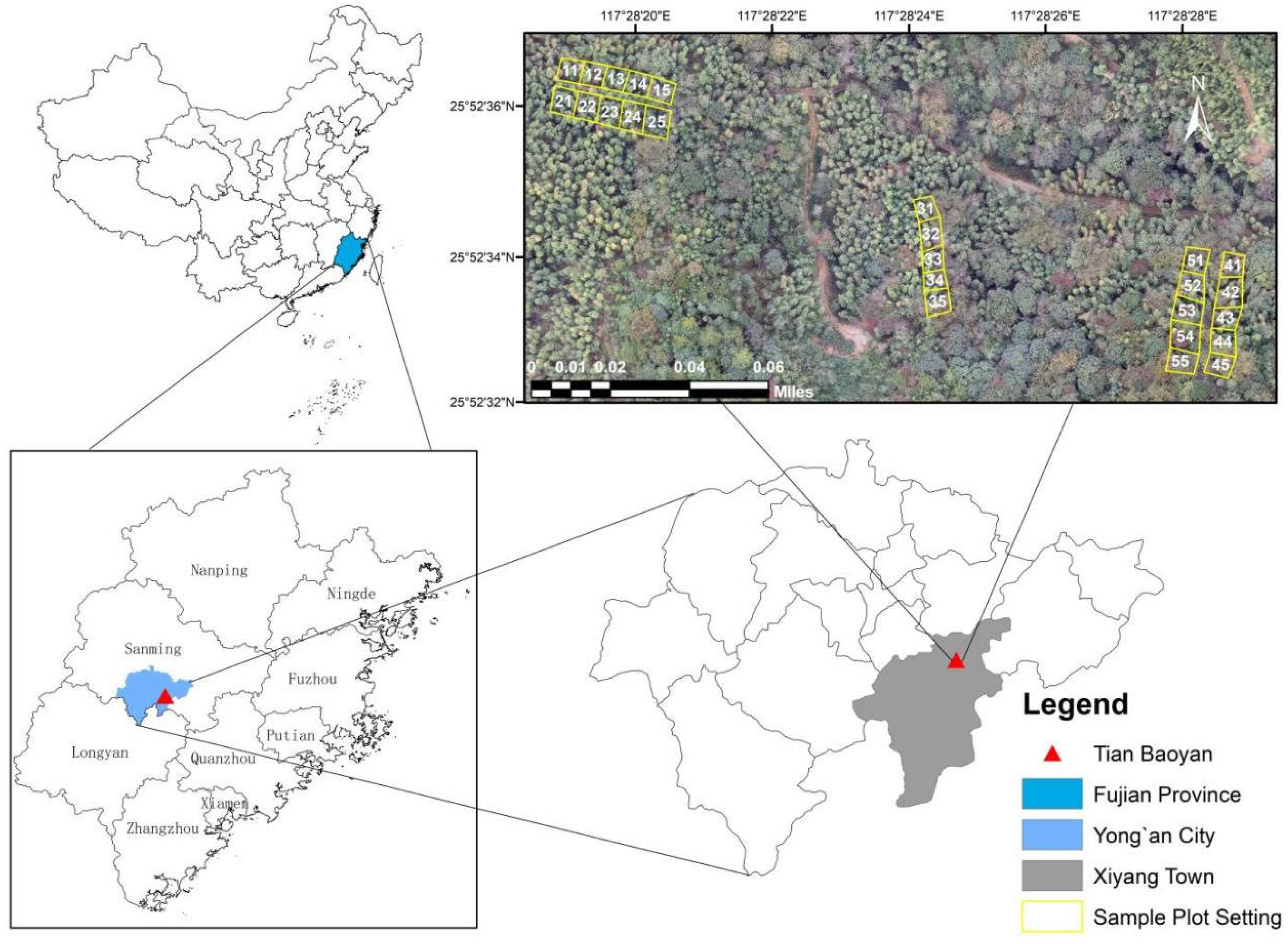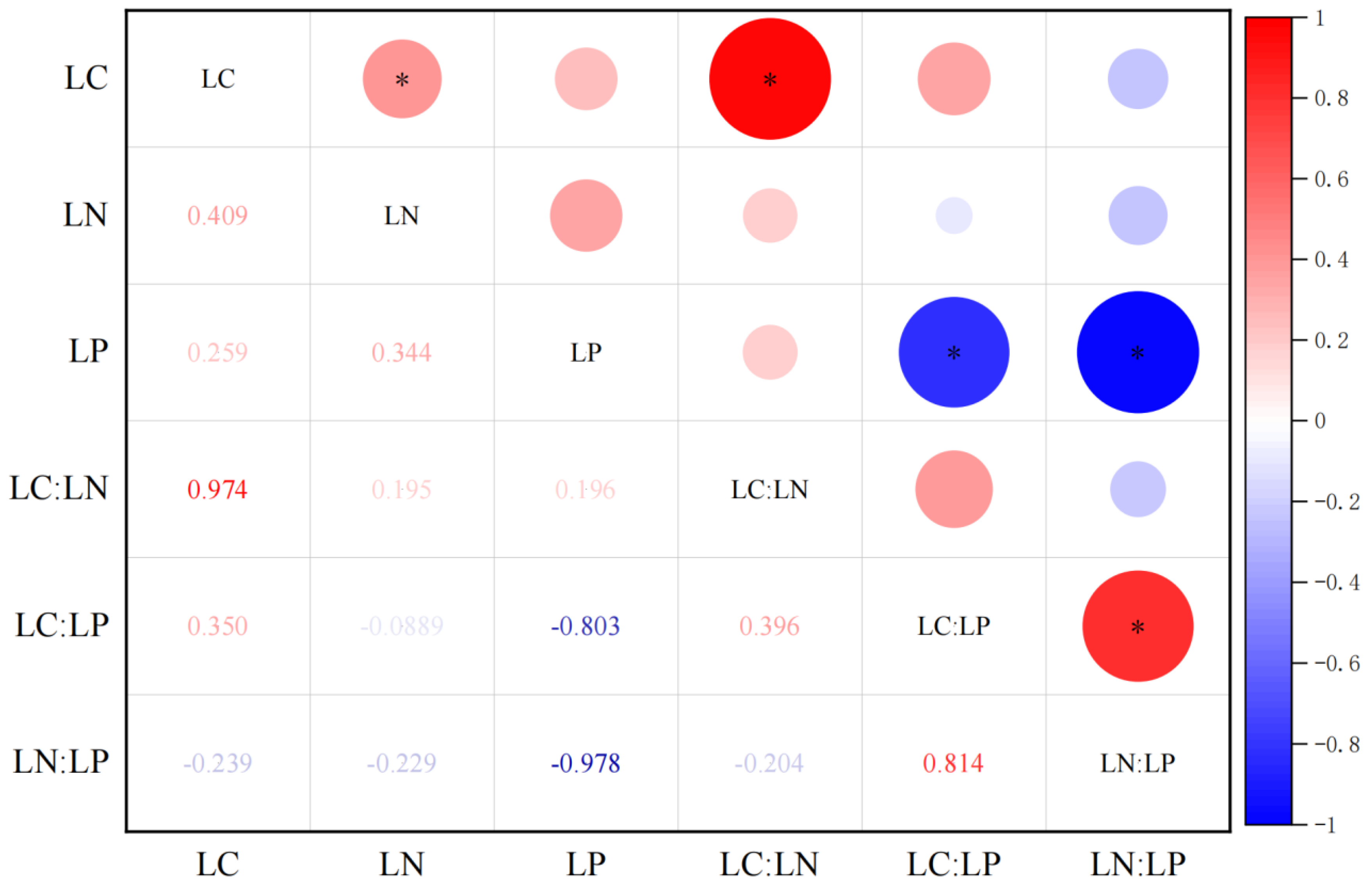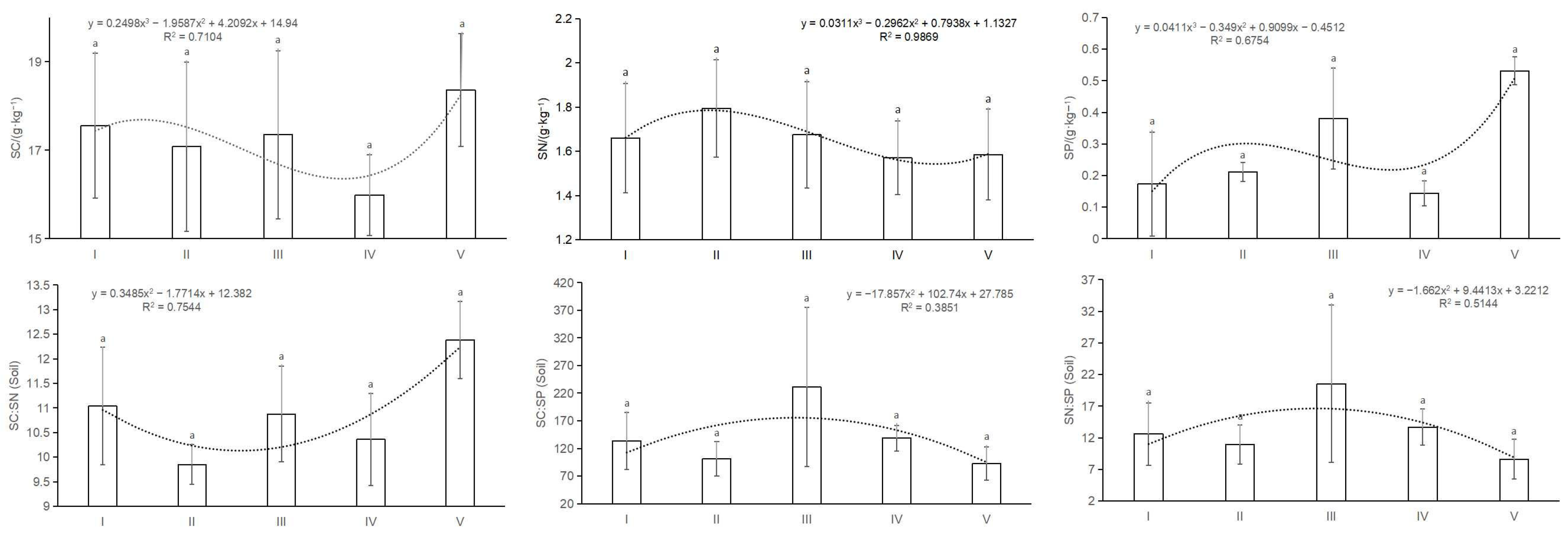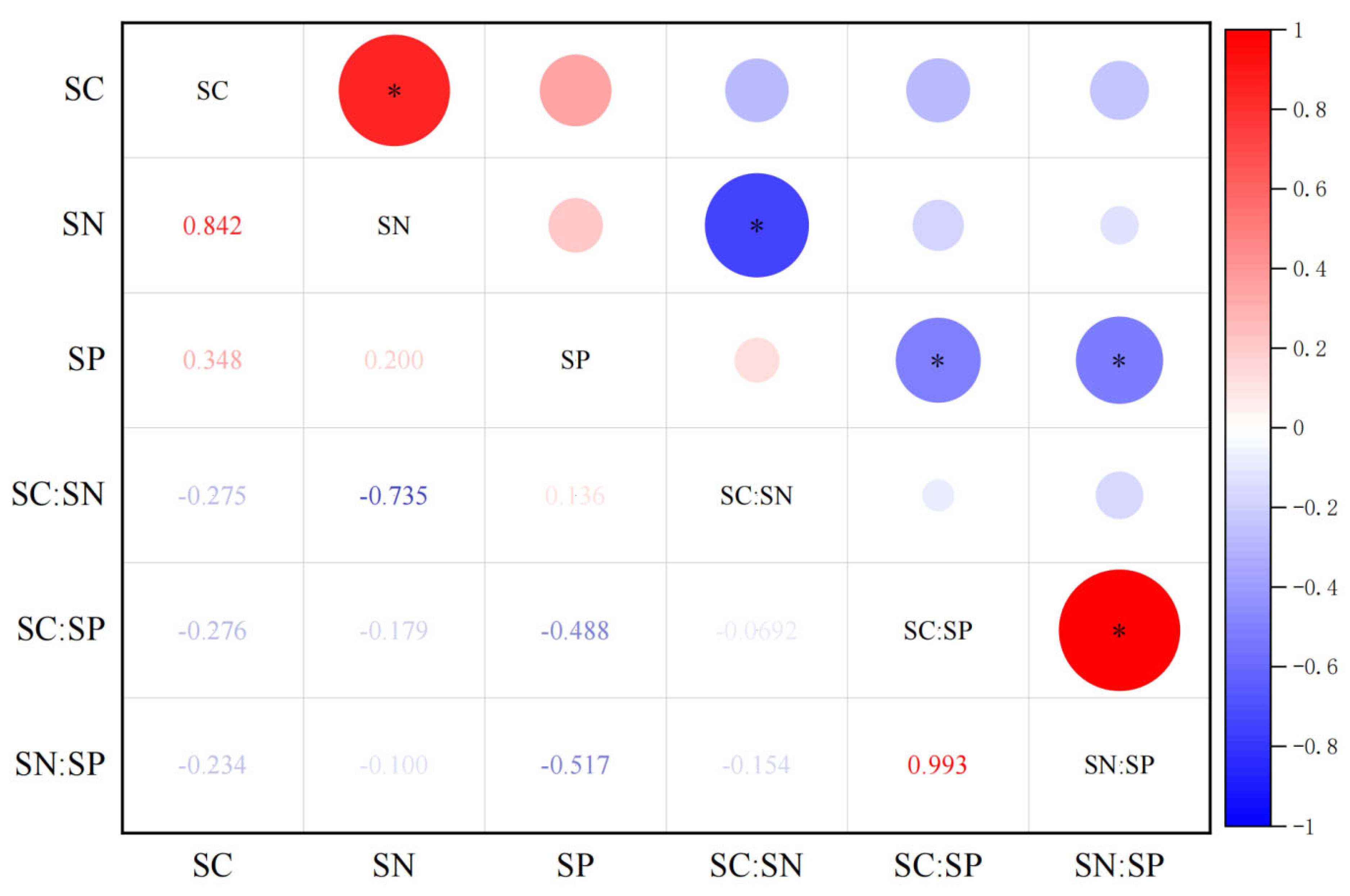Carbon, Nitrogen, and Phosphorus Stoichiometry between Leaf and Soil Exhibit the Different Expansion Stages of Moso Bamboo (Phyllostachys edulis (Carriere) J. Houzeau) into Chinese Fir (Cunninghamia lanceolata (Lamb.) Hook.) Forest
Abstract
1. Introduction
2. Materials and Methods
2.1. Site Description
2.2. Experimental Design
2.3. Leaf and Soil Sampling
2.4. Data Processing and Analysis
3. Results
3.1. Carbon, Nitrogen, and Phosphorus Stoichiometry Characteristics of Moso Bamboo Leaves at Different Stages of Expansion towards Chinese Fir Forest
3.2. Carbon, Nitrogen, and Phosphorus Stoichiometry Characteristics of Woodland Soils at Different Stages of Expansion towards Chinese Fir Forests
3.3. Carbon, Nitrogen, and Phosphorus Stoichiometry Relationships and Homoeostasis Characteristics between Moso Bamboo Leaves and Stand Soils at Different Stages of Expansion into Chinese Fir Forest
4. Discussion
4.1. Effect of Moso Bamboo Expansion to Stand on Carbon, Nitrogen, and Phosphorus Stoichiometry Characteristics of Moso Bamboo Leaves
4.2. Effects of Moso Bamboo Expansion to Stand on Carbon, Nitrogen, and Phosphorus Stoichiometry Characteristics of Moso Bamboo Soils
4.3. Effects of Moso Bamboo Expansion into Forest Stands on Carbon, Nitrogen, and Phosphorus Stoichiometry Relationships between Moso Bamboo Leaves and Forest Soils and Their Homeostasis Characteristics
5. Conclusions
Author Contributions
Funding
Data Availability Statement
Acknowledgments
Conflicts of Interest
References
- Hu, Y.P.; Zhang, Y.; Zhou, J.; Wang, G.B.; Guo, Q.R. Transcriptome Reveals the Specificity of Phyllostachys edulis ‘Pachyloen’ Shoots at Different Developmental Stages. Forests 2020, 11, 861. [Google Scholar] [CrossRef]
- Mustafa, A.A.; Derise, M.R.; Yong, W.T.L.; Rodrigues, K.R. A Concise Review of Dendrocalamus asper and Related Bamboos: Germplasm Conservation, Propagation and Molecular Biology. Plants 2021, 10, 1987. [Google Scholar] [CrossRef] [PubMed]
- Guan, F.; Tang, X.; Fan, S.; Zhao, J.; Peng, C. Changes in soil carbon and nitrogen stocks followed the conversion from secondary forest to Chinese fir and Moso bamboo plantations. CATENA 2015, 133, 455–460. [Google Scholar] [CrossRef]
- Ramakrishnan, M.; Yrjala, K.; Vinod, K.K.; Sharma, A.; Cho, J.N.; Satheesh, V.; Zhou, M.B. Genetics and genomics of Moso bamboo (Phyllostachys edulis): Current status, future challenges, and biotechnological opportunities toward a sustainable bamboo industry. Food Energy Secur. 2020, 9, e229. [Google Scholar] [CrossRef]
- Suzuki, S.; Nakagoshi, N. Expansion of bamboo forests caused by reduced bamboo-shoot harvest under different natural and artificial conditions. Ecol. Res. 2008, 23, 641–647. [Google Scholar] [CrossRef]
- Ying, W.; Jin, J.; Jiang, H.; Zhang, X.; Lu, X.; Chen, X.; Zhang, J. Satellite-based detection of bamboo expansion over the past 30 years in Mount Tianmushan, China. Int. J. Remote Sens. 2016, 37, 2908–2922. [Google Scholar] [CrossRef]
- Wu, C.; Mo, Q.; Wang, H.; Zhang, Z.; Huang, G.; Ye, Q.; Zou, Q.; Kong, F.; Liu, Y.; Wang, G.G. Moso bamboo (Phyllostachys edulis (Carriere) J. Houzeau) invasion affects soil phosphorus dynamics in adjacent coniferous forests in subtropical China. Ann. For. Sci. 2018, 75, 24. [Google Scholar] [CrossRef]
- Xu, Q.; Liang, C.; Chen, J.; Li, Y.; Qin, H.; Fuhrmann, J.J. Rapid bamboo invasion (expansion) and its effects on biodiversity and soil processes +. Glob. Ecol. Conserv. 2019, 21, e00787. [Google Scholar] [CrossRef]
- Fernández-Martínez, M. From atoms to ecosystems: Elementome diversity meets ecosystem functioning. New Phytol. 2022, 234, 35–42. [Google Scholar] [CrossRef]
- Yu, M.; Tao, Y.; Liu, W.; Xing, W.; Liu, G.; Wang, L.; Ma, L. C, N, and P stoichiometry and their interaction with different plant communities and soils in subtropical riparian wetlands. Environ. Sci. Pollut. Res. 2020, 27, 1024–1034. [Google Scholar] [CrossRef]
- Elser, J.J.; Fagan, W.F.; Denno, R.D.; Dobberfuhl, D.R.; Folarin, A.; Huberty, A.; Interlandi, S.; Kilham, S.S.; McCauley, E.; Schulz, K.L.; et al. Nutritional constraints in terrestrial and freshwater food webs. Nature 2000, 408, 578–580. [Google Scholar] [CrossRef] [PubMed]
- Perez-Quezada, J.F.; Pérez, C.A.; Brito, C.E.; Fuentes, J.P.; Gaxiola, A.; Aguilera-Riquelme, D.; Lopatin, J. Biotic and abiotic drivers of carbon, nitrogen and phosphorus stocks in a temperate rainforest. Forest Ecol. Manag. 2021, 494, 119341. [Google Scholar] [CrossRef]
- Chen, H.; Huang, X.; Shi, W.; Kronzucker, H.J.; Hou, L.; Yang, H.; Song, Q.; Liu, J.; Shi, J.; Yang, Q.; et al. Coordination of nitrogen uptake and assimilation favours the growth and competitiveness of Moso bamboo over native tree species in high-NH4+ environments. J. Plant Physiol. 2021, 266, 153508. [Google Scholar] [CrossRef] [PubMed]
- Li, F.L.; Zhong, L.; Wen, W.; Tian, T.T.; Li, H.C.; Cheung, S.G.; Wong, Y.S.; Shin, P.K.S.; Zhou, H.C.; Tam, N.F.Y.; et al. Do distribution and expansion of exotic invasive Asteraceae plants relate to leaf construction cost in a man-made wetland? MAR Pollut. Bull. 2021, 163, 111958. [Google Scholar] [CrossRef] [PubMed]
- Zhong, Y.; Zhong, Q.; Li, B.; Yu, H.; Xu, C.; Cheng, D.; Le, X.; Zheng, W. Effects of Phyllostachys Edulis expansion on leaf structural traits of main tree species in subtropical evergreen broad-leaved forests. Acta Ecol. Sin. 2020, 40, 5018–5028. [Google Scholar]
- Camenzind, T.; Philipp Grenz, K.; Lehmann, J.; Rillig, M.C. Soil fungal mycelia have unexpectedly flexible stoichiometric C: N and C: P ratios. Ecol. Lett. 2020, 24, 208–218. [Google Scholar] [CrossRef]
- Liu, W.; Liao, L.; Liu, Y.; Wang, Q.; Murray, P.J.; Jiang, X.; Zou, G.; Cai, J.; Zhao, X. Effects of Phyllostachys pubescens expansion on underground soil fauna community and soil food web in a Cryptomeria japonica plantation, Lushan Mountain, subtropical China. J. Soil. Sediment. 2021, 21, 2212–2227. [Google Scholar] [CrossRef]
- Terefe, R.; Yu, K.; Deng, Y.; Yao, X.; Wang, F.; Liu, J. Spatial variability of soil chemical properties of Moso bamboo forests of China. J. For. Res. 2021, 32, 2599–2608. [Google Scholar] [CrossRef]
- Fan, S.; Shen, J.; Liu, G.; Feng, Y.; Liu, X.; Cai, C. Soil Nutrients and Ecological Stoichiometry Characteristics after Phyllostachys edulis Expansion to Cunninghamia lanceolata Forest. Acta Bot. Boreal. Occident. Sin. 2019, 39, 1455–1462. [Google Scholar]
- Tian, X.K.; Ge, X.G.; Zhou, B.Z.; Li, M.H. The Linkage of Soil CO2 Emissions in a Moso Bamboo (Phyllostachys edulis (Carriere) J. Houzeau) Plantation with Aboveground and Belowground Stoichiometry. Forests 2021, 12, 1052. [Google Scholar] [CrossRef]
- Bao, S. Soil and Agricultural Chemistry Analysis; China Agriculture Press: Beijing, China, 2019. [Google Scholar]
- Persson, J.; Fink, P.; Goto, A.; Hood, J.M.; Jonas, J.; Kato, S. To be or not to be what you eat: Regulation of stoichiometric homeostasis among autotrophs and heterotrophs. Oikos 2010, 119, 741–751. [Google Scholar] [CrossRef]
- Inoue, A.; Miyazawa, Y.; Sato, M.; Shima, H. Allometric Equations for Predicting Culm Surface Area of Three Bamboo Species (Phyllostachys spp.). Forests 2018, 9, 295. [Google Scholar] [CrossRef]
- Su, Y.H.; Song, X.Q.; Zheng, J.W.; Zhang, Z.H.; Tang, Z.H. Ecological Stoichiometric Characteristics of C, N and P and Their Relationship with Soil Factors from Different Organs of the Halophytic Chenopodiaceae Plants in Hulunbuir. Bull. Bot. Res. 2022, 42, 910–920. [Google Scholar]
- Qiu, J.; Dai, H.T.; Xing, Y.Z.; Huang, D.J.; Yin, Q.J.; Cheng, D.W. Leaves, stems and roots stoichiometry characteristics of mangrove plants at different succession stages in Shankou National Mangrove Nature Reserve, China. J. Trop. Oceanogr. 2022. online. [Google Scholar]
- Wang, Z.N.; Lu, J.Y.; Yang, M.; Yang, H.M.; Zhang, Q.P. Stoichiometric Characteristics of Carbon, Nitrogen, and Phosphorus in Leaves of Differently Aged Lucerne (Medicago sativa) Stands. Front. Plant Sci. 2015, 6, 1062. [Google Scholar] [CrossRef]
- Song, Q.N.; Lu, H.; Liu, J.; Yang, J.; Yang, G.Y.; Yang, Q.P. Accessing the impacts of bamboo expansion on NPP and N cycling in evergreen broadleaved forest in subtropical China. Sci. Rep. 2017, 7, 40383. [Google Scholar] [CrossRef]
- Liang, C.; Schimel, J.P.; Jastrow, J.D. The importance of anabolism in microbial control over soil carbon storage. Nat. Microbiol. 2017, 2, 17105. [Google Scholar] [CrossRef]
- Rafael, R.B.A.; Rogerio, B.; Fernandez-Marcos, M.L.; Cocco, S.; Ruello, M.L.; Fornasier, F.; Corti, G. Increased phosphorus availability to corn resulting from the simultaneous applications of phosphate rock, calcareous rock, and biochar to an acid sandy soil. Pedosphere 2020, 30, 719–733. [Google Scholar] [CrossRef]
- Liu, X.S.; Siemann, E.; Cui, C.; Liu, Y.Q.; Guo, X.M.; Zhang, L. Moso bamboo (Phyllostachys edulis) invasion effects on litter, soil and microbial PLFA characteristics depend on sites and invaded forests. Plant Soil 2019, 438, 85–99. [Google Scholar] [CrossRef]
- Shao, S.; Zhao, Y.; Zhang, W.; Hu, G.Q.; Xie, H.T.; Yan, J.H.; Han, S.J.; He, H.B.; Zhang, X.D. Linkage of microbial residue dynamics with soil organic carbon accumulation during subtropical forest succession. Soil Biol. Biochem. 2017, 114, 114–120. [Google Scholar] [CrossRef]
- Li, S.J.; Qin, Y.Y. Variation pattern and interaction of leaf stoichiometry with slope aspect in the central Qilian Mountains, Northwest China. Appl. Ecol. Environ. Res. 2021, 19, 2629–2647. [Google Scholar] [CrossRef]
- Deans, R.M.; Brodribb, T.J.; Busch, F.A.; Farquhar, G.D. Optimization can provide the fundamental link between leaf photosynthesis, gas exchange and water relations. Nat. Plants 2020, 6, 1116–1125. [Google Scholar] [CrossRef] [PubMed]
- Du, M.; Fan, S.; Liu, G.; Feng, H.; Guo, B.; Tang, X. Stoichiometric characteristics of carbon, nitrogen and phosphorus in Phyllostachys edulis forests of China. Chin. J. Plant Ecol. 2016, 40, 760–774. [Google Scholar]
- Li, P.; Ling, T.; Yang, Z.; Chen, H.; Yan, P.; Lu, S.; Ling, J.; Tang, S. Ecological Stoichiometric Characteristics of Leaf-soil Carbon, Nitrogen and Phosphorus in Different Forest Ages of Pinus massoniana. J. Southwest For. Univ. (Nat. Sci.) 2022, 42, 1–12. [Google Scholar]
- Elser, J.J.; Sterner, R.W.; Gorokhova, E.; Fagan, W.F.; Markow, T.A.; Cotner, J.B.; Harrison, J.F.; Hobbie, S.E.; Odell, G.M.; Weider, L.W. Biological stoichiometry from genes to ecosystems. Ecol. Lett. 2000, 3, 540–550. [Google Scholar] [CrossRef]
- Chang, S.; Wu, J. Green-color conservation of ma bamboo (Dendrocalamus latiflorus) treated with chromium-based reagents. J. Wood Sci. 2000, 46, 40–44. [Google Scholar] [CrossRef]
- Wu, M.; Liu, R.; Gao, Y.; Xiong, R.; Shi, Y.; Xiang, Y. PheASR2, a novel stress-responsive transcription factor from Moso bamboo (Phyllostachys edulis), enhances drought tolerance in transgenic rice via increased sensitivity to abscisic acid. Plant Physiol. Biochem. 2020, 154, 184–194. [Google Scholar] [CrossRef]
- Zhang, H.; Guo, W.; Wang, G.G.; Yu, M.; Wu, T. Effect of environment and genetics on leaf N and P stoichiometry for Quercus acutissima across China. Eur. J. For. Res. 2016, 135, 795–802. [Google Scholar] [CrossRef]
- Niu, D.; Zhang, C.; Ma, P.; Fu, H.; Elser, J.J. Responses of leaf C:N:P stoichiometry to water supply in desert shrub Zygophyllum xanthoxylum. Plant Biol. 2018, 21, 82–88. [Google Scholar] [CrossRef]
- Sun, H.; Li, Q.; Lei, Z.; Zhang, J.; Song, X.; Song, X. Ecological stoichiometry of nitrogen and phosphorus in Moso bamboo (Phyllostachys edulis) during the explosive growth period of new emergent shoots. J. Plant Res. 2018, 132, 107–115. [Google Scholar] [CrossRef]
- Liao, X.; Qiu, L.; Zhang, Y.; Liu, J.; Wan, S.; Yang, G. Effects of Thinning and Understory Removal on Leaf Nitrogen and Phosphorus Stoichiometric Characteristics in Moso Bamboo Plantation. Acta Agric. Univ. Jiangxiensis 2020, 42, 802–810. [Google Scholar]
- Okutomi, K.; Shinoda, S.; Fukuda, H. Causal analysis of the invasion of broad-leaved forest by bamboo in Japan. J Veg. Sci. 1996, 7, 723–728. [Google Scholar] [CrossRef]
- Ma, X.; Zheng, C.; Hu, Y.; Qin, H.; Chen, J.; Xu, Q.; Liang, C. Effects of moso bamboo (Phyllostachys edulis) expansion on soil microbial community in evergreen broad-leaved forest. J. Appl. Ecol. 2022, 33, 1091–1098. [Google Scholar]
- Brust, G.E. Management Strategies for Organic Vegetable Fertility. Saf. Pract. Org. Food 2019, 193–212. Available online: https://doi.org/10.1016/B978-0-12-812060-6.00009-X (accessed on 10 October 2022).
- Kim, C.; Baek, G.; Yoo, B.O.; Jung, S.; Lee, K.S. Regular Fertilization Effects on the Nutrient Distribution of Bamboo Components in a Moso Bamboo (Phyllostachys pubescens (Mazel) Ohwi) Stand in South Korea. Forests 2018, 9, 671. [Google Scholar] [CrossRef]
- Ni, H.; Su, W.; Fan, S.; Chu, H. Effects of intensive management practices on rhizosphere soil properties, root growth, and nutrient uptake in Moso bamboo plantations in subtropical China. For. Ecol. Manag. 2021, 493, 119083. [Google Scholar] [CrossRef]
- Song, X.; Li, Q.; Gu, H. Effect of nitrogen deposition and management practices on fine root decomposition in Moso bamboo plantations. Plant Soil 2016, 410, 207–215. [Google Scholar] [CrossRef]
- Lehmann, J. A handful of carbon. Nature 2007, 447, 143–144. [Google Scholar] [CrossRef]
- Mitchell, P.J.; Simpson, A.J.; Soong, R.; Schurman, J.S.; Thomas, S.C.; Simpson, M.J. Biochar amendment and phosphorus fertilization altered forest soil microbial community and native soil organic matter molecular composition. Biogeochemistry 2016, 130, 227–245. [Google Scholar] [CrossRef]
- Koerselman, W.; Meuleman, A.F.M. The vegetation N:P ratio: A new tool to detect the nature of nutrient limitation. J. Appl. Ecol. 1996, 33, 1441–1450. [Google Scholar] [CrossRef]
- Yan, J.; Li, K.; Peng, X.; Huang, Z.; Liu, S.; Zhang, Q. The mechanism for exclusion of Pinus massoniana during the succession in subtropical forest ecosystems: Light competition or stoichiometric homoeostasis? Sci. Rep. 2015, 5, 10994. [Google Scholar] [CrossRef] [PubMed]





| Sites | Density of Moso Bamboo (Plants/hm2) | Diameter at Breast Height of Moso Bamboo (cm) | Percentage of Moso Bamboo (%) | Diameter at Breast Height of Chinese Fir (cm) | Percentage of Chinese Fir (%) | Expansion Stage | |
|---|---|---|---|---|---|---|---|
| Tape1 | 11 | 2220 | 9.83 | 85.20 | 12.93 | 14.80 | V |
| 12 | 890 | 8.73 | 45.00 | 14.97 | 50.00 | IV | |
| 13 | 610 | 9.31 | 40.00 | 16.44 | 60.00 | III | |
| 14 | 700 | 9.38 | 50.00 | 15.06 | 50.00 | II | |
| 15 | 100 | 8.70 | 0.08 | 15.79 | 0.92 | I | |
| Tape2 | 22 | 3780 | 9.28 | 79.60 | 13.84 | 20.40 | V |
| 21 | 940 | 9.18 | 52.40 | 10.21 | 47.60 | IV | |
| 23 | 920 | 9.59 | 48.10 | 13.62 | 51.90 | III | |
| 24 | 280 | 4.53 | 14.30 | 13.09 | 75.00 | II | |
| 25 | 125 | 7.61 | 9.10 | 13.03 | 81.80 | I | |
| Tape3 | 31 | 2690 | 11.20 | 76.10 | 11.22 | 23.90 | V |
| 32 | 1640 | 10.56 | 60.70 | 12.84 | 35.70 | IV | |
| 33 | 1450 | 11.37 | 63.60 | 15.28 | 31.80 | III | |
| 34 | 440 | 11.20 | 31.80 | 11.70 | 50.00 | II | |
| 35 | 70 | 11.40 | 4.17 | 8.00 | 87.50 | I | |
| Tape4 | 41 | 2940 | 12.30 | 96.80 | 10.20 | 3.20 | V |
| 42 | 1810 | 11.02 | 82.80 | 11.12 | 20.80 | IV | |
| 43 | 1960 | 11.96 | 65.90 | 13.21 | 34.10 | III | |
| 44 | 510 | 12.29 | 25.90 | 12.21 | 74.10 | II | |
| 45 | 0 | - | 0.00 | 8.32 | 77.10 | I | |
| Tape5 | 51 | 2120 | 13.33 | 83.90 | 10.35 | 6.50 | V |
| 52 | 1550 | 12.46 | 64.50 | 9.95 | 19.40 | IV | |
| 53 | 860 | 12.17 | 41.70 | 11.80 | 58.30 | III | |
| 54 | 440 | 14.10 | 17.20 | 9.72 | 69.00 | II | |
| 55 | 0 | - | 0.00 | 9.05 | 100.00 | I | |
| Expansion Stage | Stoichiometric Correlation | ||||||
|---|---|---|---|---|---|---|---|
| LC | LN | LP | LC:LN | LC:LP | LN:LP | ||
| I | SC | 0.313 | 0.409 | −0.120 | 0.256 | 0.123 | 0.069 |
| SN | 0.262 | 0.470 | −0.073 | 0.178 | 0.062 | 0.021 | |
| SP | −0.363 | −0.102 | −0.336 | −0.402 | 0.130 | 0.302 | |
| SC:SN | −0.149 | −0.569 | −0.147 | −0.016 | 0.158 | 0.191 | |
| SC:SP | 0.643 | 0.574 | 0.283 | 0.604 | −0.032 | −0.249 | |
| SN:SP | 0.668 | 0.628 | 0.206 | 0.618 | 0.025 | −0.183 | |
| II | SC | 0.207 | 0.358 | 0.723 | 0.064 | −0.675 | −0.795 |
| SN | 0.267 | 0.292 | 0.032 | 0.127 | −0.052 | −0.101 | |
| SP | −0.554 | −0.078 | −0.401 | −0.418 | 0.328 | 0.527 | |
| SC:SN | −0.266 | −0.001 | 0.560 | −0.207 | −0.512 | −0.515 | |
| SC:SP | 0.493 | 0.005 | 0.270 | 0.392 | −0.210 | −0.384 | |
| SN:SP | 0.433 | 0.073 | 0.178 | 0.325 | −0.143 | −0.281 | |
| III | SC | 0.700 | 0.046 | −0.554 | 0.753 | 0.846 | 0.516 |
| SN | 0.543 | 0.394 | −0.463 | 0.513 | 0.677 | 0.534 | |
| SP | 0.554 | 0.296 | 0.087 | 0.544 | 0.327 | −0.058 | |
| SC:SN | −0.195 | −0.748 | 0.175 | −0.064 | −0.255 | −0.373 | |
| SC:SP | −0.123 | 0.367 | 0.542 | −0.207 | −0.414 | −0.424 | |
| SN:SP | −0.126 | 0.399 | 0.512 | −0.218 | −0.397 | −0.383 | |
| IV | SC | 0.684 | 0.881 * | −0.458 | 0.526 | 0.920 * | 0.718 |
| SN | 0.820 | 0.823 | −0.359 | 0.716 | 0.941 * | 0.613 | |
| SP | 0.275 | 0.776 | 0.118 | 0.052 | 0.126 | 0.115 | |
| SC:SN | −0.805 | −0.265 | −0.072 | −0.905 * | −0.569 | −0.044 | |
| SC:SP | −0.082 | −0.520 | −0.036 | 0.103 | −0.010 | −0.094 | |
| SN:SP | 0.037 | −0.453 | −0.014 | 0.226 | 0.064 | −0.091 | |
| V | SC | 0.447 | −0.447 | −0.188 | 0.558 | 0.665 | 0.222 |
| SN | 0.443 | −0.599 | −0.374 | 0.585 | 0.864 | 0.366 | |
| SP | 0.847 | 0.639 | 0.902 * | 0.766 | −0.460 | −0.891 * | |
| SC:SN | −0.252 | 0.658 | 0.577 | −0.397 | −0.922 * | −0.525 | |
| SC:SP | −0.597 | −0.896 * | −0.913 * | −0.454 | 0.737 | 0.944 * | |
| SN:SP | −0.578 | −0.903 * | −0.919 * | −0.432 | 0.758 | 0.948 * | |
| Expansion Stage | Homeostasis Coefficient (1/H) | ||
|---|---|---|---|
| N | P | N:P | |
| I | 0.02 | 0.09 | 0.06 |
| II | 0.02 | 0.13 | 0.07 |
| III | 0.03 | 0.02 | 0.80 |
| IV | 0.08 | 0.01 | 0.01 |
| V | 0.04 | 0.18 | 0.14 |
Publisher’s Note: MDPI stays neutral with regard to jurisdictional claims in published maps and institutional affiliations. |
© 2022 by the authors. Licensee MDPI, Basel, Switzerland. This article is an open access article distributed under the terms and conditions of the Creative Commons Attribution (CC BY) license (https://creativecommons.org/licenses/by/4.0/).
Share and Cite
Li, C.; Zhong, Q.; Yu, K.; Li, B. Carbon, Nitrogen, and Phosphorus Stoichiometry between Leaf and Soil Exhibit the Different Expansion Stages of Moso Bamboo (Phyllostachys edulis (Carriere) J. Houzeau) into Chinese Fir (Cunninghamia lanceolata (Lamb.) Hook.) Forest. Forests 2022, 13, 1830. https://doi.org/10.3390/f13111830
Li C, Zhong Q, Yu K, Li B. Carbon, Nitrogen, and Phosphorus Stoichiometry between Leaf and Soil Exhibit the Different Expansion Stages of Moso Bamboo (Phyllostachys edulis (Carriere) J. Houzeau) into Chinese Fir (Cunninghamia lanceolata (Lamb.) Hook.) Forest. Forests. 2022; 13(11):1830. https://doi.org/10.3390/f13111830
Chicago/Turabian StyleLi, Conghui, Quanlin Zhong, Kunyong Yu, and Baoyin Li. 2022. "Carbon, Nitrogen, and Phosphorus Stoichiometry between Leaf and Soil Exhibit the Different Expansion Stages of Moso Bamboo (Phyllostachys edulis (Carriere) J. Houzeau) into Chinese Fir (Cunninghamia lanceolata (Lamb.) Hook.) Forest" Forests 13, no. 11: 1830. https://doi.org/10.3390/f13111830
APA StyleLi, C., Zhong, Q., Yu, K., & Li, B. (2022). Carbon, Nitrogen, and Phosphorus Stoichiometry between Leaf and Soil Exhibit the Different Expansion Stages of Moso Bamboo (Phyllostachys edulis (Carriere) J. Houzeau) into Chinese Fir (Cunninghamia lanceolata (Lamb.) Hook.) Forest. Forests, 13(11), 1830. https://doi.org/10.3390/f13111830






